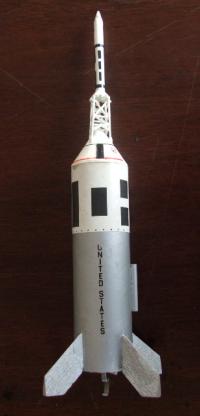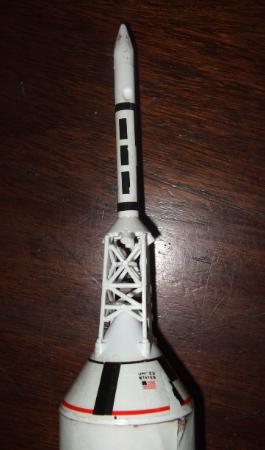Estes Little Joe II (0892)
Estes - Little Joe II {Kit} (892) [1991-1992]
Contributed by Matt Gillard
| Construction Rating: | starstarstarstarstar_border |
| Flight Rating: | starstarstarstarstar_border |
| Overall Rating: | starstarstarstarstar_border |
| Diameter: | 1.54 inches |
| Length: | 10.50 inches |
| Manufacturer: | Estes  |
| Skill Level: | 3 |
| Style: | Scale |
 Brief:
Brief:
A 1/100th scale rocket that's been out of production for some time now. This version #0892 was the second that Estes produced, the first being the K-30.
I built this rocket more or less at the start of my rocket building history. It was my first scale rocket, and I did not do a great job on it. Its had quite a few flights now and is starting to show wear and tear. I'm writing the review because there are so many flight logs and they need something to sit under.
Construction:
Kit consists of:
- 1 launch lug
- Estes paper shock cord mount
- 1 length elastic shock cord
- 12 inch parachute (Needs to be made)
- Bag of Apollo capsule parts
- Body tube
- Engine mount tube
- Engine hook
- balsa fins strip
- Decal sheet
- Printed roll pattern
- Embossed body wrap
- Screw eye
- Die cut rings
To build the kit I used:
- Model knife
- Aluminium oxide sand paper
- White PVA glue
- Enamel spray paint
The rocket was an interesting build mainly because unlike recent Estes kits, the Little Joe II rocket requires some skill.
The motor mount build was like all motor mounts, but the only modification I made was to add a length of Kevlarcord between the motor mount and the shock cord, which was the old style elastic. The mount is then glued into the body tube.
An embossed sheet of cardstock is then wrapped around the body tube using spray adhesive. (My rocket build did not have this wrap, as I ruined the wrap before this stage--this is why I originally did not write a review). Strips of card are then added to the body tube, covering the seam.
The four fins are cut from a triangular strip of quite dense balsa using a fin pattern. The fins are unusual in shape. Fillets of white glue are then added to the joins between fins and body tube.
Silver spray paint is used to cover the bottom part of the body tube; the top part will have a printed wrap added.
 The nose cone is a more difficult build and is probably why the rocket has been given a skill level of three, although I think the build is more like a hard 2. The capsule is plastic and comes in several parts. Plastic cement is needed. The trickiest part is keeping everything in place whilst the cement sets. The screw eye is then fixed to the base of the capsule.
The nose cone is a more difficult build and is probably why the rocket has been given a skill level of three, although I think the build is more like a hard 2. The capsule is plastic and comes in several parts. Plastic cement is needed. The trickiest part is keeping everything in place whilst the cement sets. The screw eye is then fixed to the base of the capsule.
A further wrap is then added to the top of the body tube.
Finishing:
Waterslide decals are supplied which went on well, although the top decal is difficult to apply.
Construction Rating: 4 out of 5
Flight:
Flies on A3-4T, A10-3T motors, which the instructions says give a height of 425 feet.
The body tube has plenty of space for the parachute, which needs to be protected by 3-4 sheets of wadding.
Flights are good, check out the logs below.
Recovery:
12-inch parachute provided a decent rate of descent.
Flight Rating: 4 out of 5
Overall Rating: 4 out of 5
 |
 |
Flights
Sponsored Ads
 |
 |











